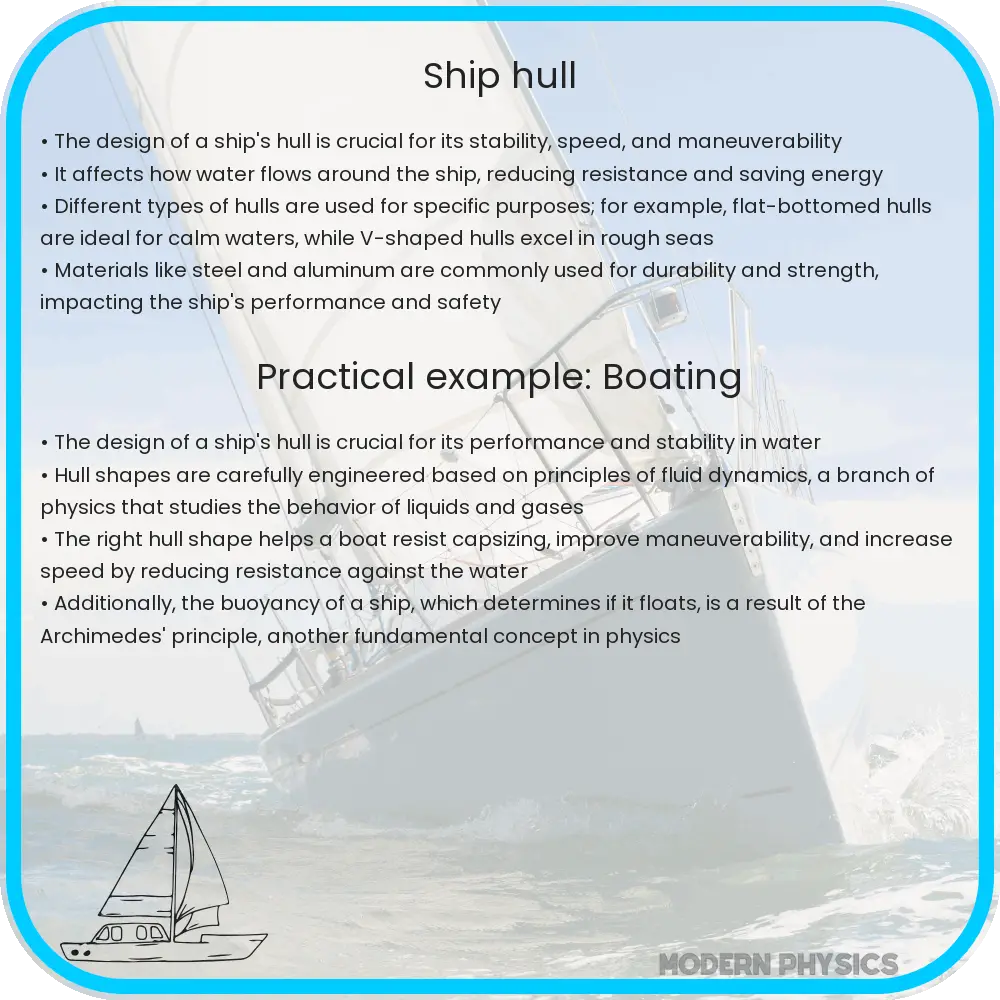Explore the essentials of ship hull design, focusing on stability, durability, load capacity, and the latest in hydrodynamic and eco-friendly advancements.

Understanding Ship Hull Design: Ensuring Stability, Durability, and Load Capacity
The design of a ship’s hull is a crucial aspect that determines its performance, safety, and efficiency. Three primary factors – stability, durability, and load capacity – play a significant role in hull design. Each of these factors is interdependent and requires careful consideration during the design process to ensure a vessel’s successful operation.
Stability in Ship Hull Design
Stability is a measure of a ship’s ability to return to its original position after being tilted by waves, wind, or other external forces. The key to achieving stability lies in the ship’s center of gravity and center of buoyancy. A lower center of gravity enhances stability, reducing the risk of capsizing. Designers often use complex calculations and simulations to optimize the hull shape and weight distribution for maximum stability.
Durability Considerations
Durability is vital for withstanding the harsh marine environment. Factors like corrosion resistance, material fatigue, and structural integrity are considered. Materials such as high-strength steel or aluminum alloys are commonly used. These materials are treated with protective coatings and advanced welding techniques to enhance their lifespan and performance. Additionally, the hull’s geometry can be designed to distribute stresses evenly, thereby reducing the likelihood of material failure.
Maximizing Load Capacity
Load capacity refers to the maximum weight a ship can safely carry, including cargo, fuel, and passengers. This is directly influenced by the hull’s design, particularly its volume and buoyancy. A well-designed hull will have enough buoyancy to support the intended load while maintaining optimal stability and safety. The Archimedes’ Principle, which states that the upward buoyant force exerted on a body immersed in a fluid is equal to the weight of the fluid displaced by the body, is a fundamental concept applied in calculating load capacity.
To illustrate, consider a ship with a displacement of D tons in water. Its load capacity can be estimated using the formula:
Load Capacity = V x ρ – D
where V is the volume of the hull under the waterline and ρ (rho) is the density of water. This formula helps in designing a hull that can carry the maximum load without compromising stability and safety.
In conclusion, the design of a ship’s hull is a complex but crucial process that integrates stability, durability, and load capacity. These elements are essential for the safe and efficient operation of maritime vessels. The next section will delve into advanced design techniques, including hydrodynamic efficiency and environmental considerations.
Advanced Design Techniques in Ship Hull Design
Modern ship hull design also incorporates advanced techniques to enhance hydrodynamic efficiency and environmental sustainability. Hydrodynamic efficiency is concerned with reducing resistance as the ship moves through water, thereby improving speed and fuel efficiency. Designers often use computational fluid dynamics (CFD) simulations to optimize the hull shape, reducing drag and turbulence. Innovations like bulbous bows and streamlined sterns are examples of hydrodynamic improvements.
Environmental considerations are increasingly important in hull design. This includes reducing greenhouse gas emissions and preventing marine pollution. Eco-friendly materials, energy-efficient propulsion systems, and hull designs that minimize wake and noise pollution are being integrated into new vessel designs.
Technological Integration in Hull Design
The integration of technology in ship hull design is revolutionizing the maritime industry. Advanced sensors and monitoring systems are being embedded within the hull structure, allowing for real-time data collection on hull performance and environmental conditions. This data is invaluable for predictive maintenance and for making adjustments to improve efficiency and safety.
Future Trends in Ship Hull Design
Looking forward, ship hull design is likely to see further innovations. These may include the use of new materials like carbon fiber composites for increased strength and reduced weight. Additionally, the trend towards autonomous ships will influence hull design, prioritizing sensor integration and remote monitoring capabilities. Sustainable design will continue to be a significant focus, with increased use of renewable energy sources like solar and wind power integrated into the hull design.
Conclusion
The design of a ship’s hull is a critical factor that impacts its stability, durability, and load capacity. It requires a delicate balance of various engineering principles and a deep understanding of maritime environments. With advancements in technology and a growing emphasis on sustainability, ship hull design is evolving rapidly. Innovations in materials, hydrodynamic efficiency, and environmental considerations are setting new standards in the industry. As we look to the future, these developments promise to make shipping more efficient, safer, and more environmentally friendly, playing a crucial role in the global economy and environmental stewardship.
